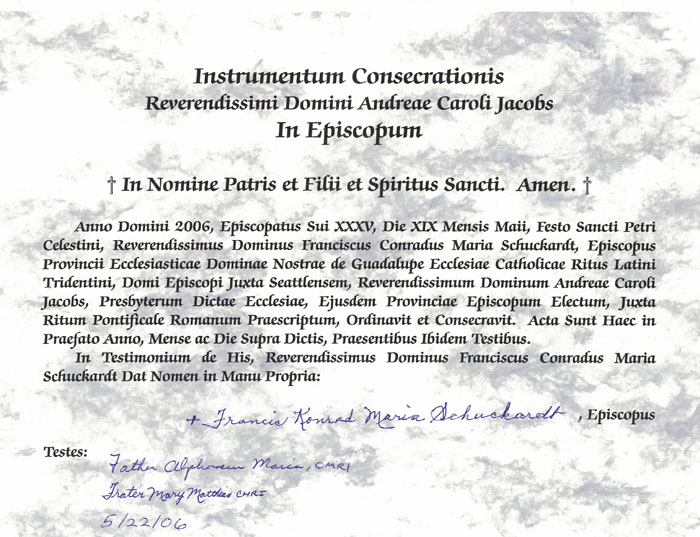

Above: Document recording the fact of the Consecration to the Episcopacy of Bishop Mary Fidelis
(Andrew Karl) Jacobs by Bishop Francis Konrad Maria Schuckardt on the Feast of Mary, Queen of the Apostles,
May 19, 2006 (which was also the Feast of St. Peter Celestine).
Below: Document naming Bishop Mary Fidelis Jacobs to be the Successor of Bishop Francis Konrad Maria Schuckardt as
Ordinary of the Ecclesiastical Province of Our Lady of Guadalupe.
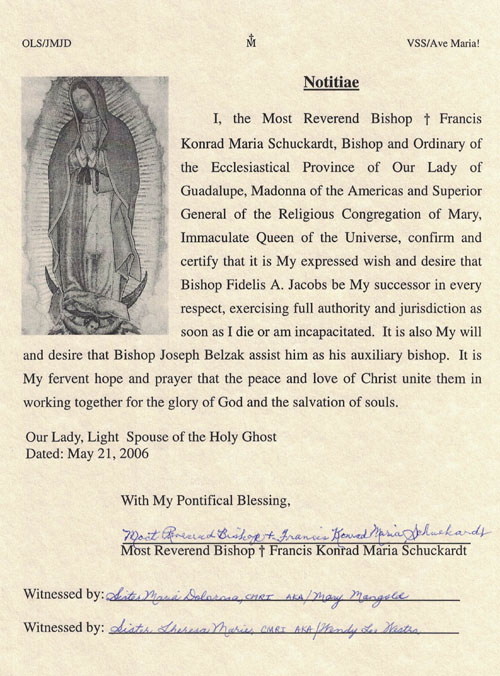
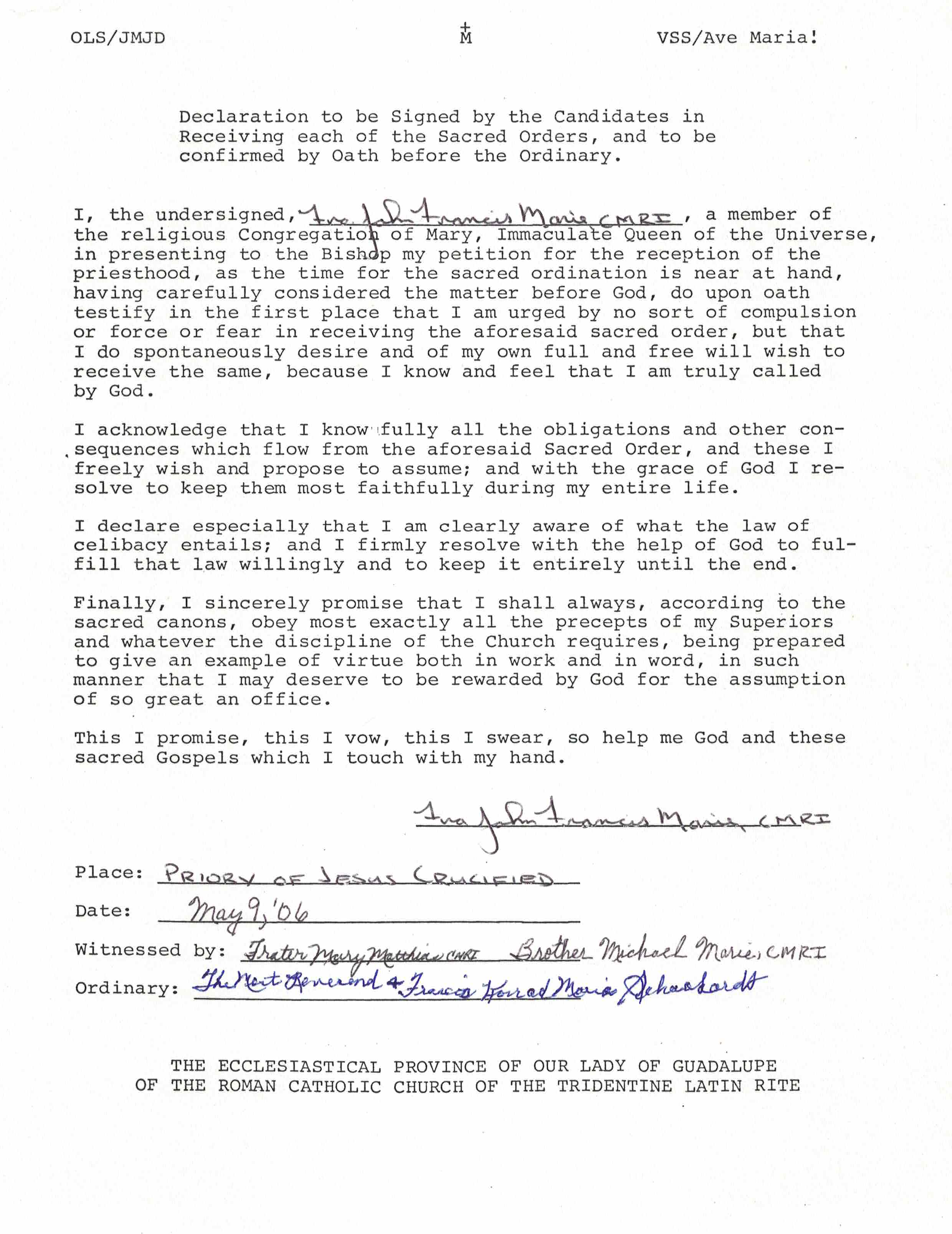
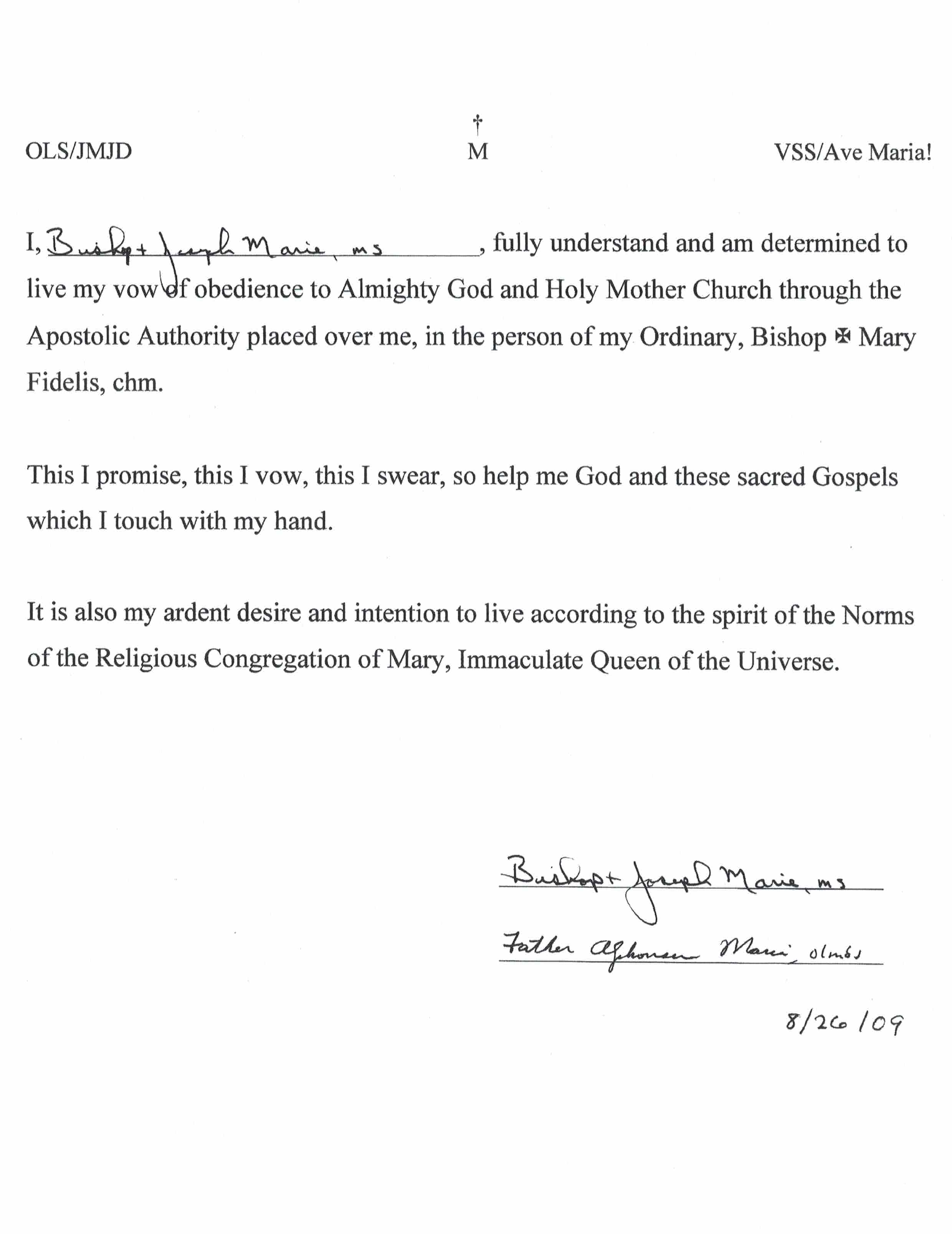
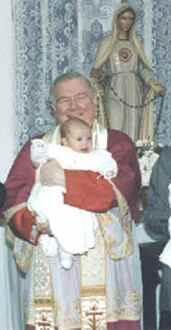 Francis
Schuckardt had both charisma and intelligence. To this only son of his
well-to-do parents, the popular young man felt his opportunities were
limitless...
Francis
Schuckardt had both charisma and intelligence. To this only son of his
well-to-do parents, the popular young man felt his opportunities were
limitless...
Bishop Francis Konrad Maria Schuckardt is a traditional Catholic bishop who founded the first traditional Catholic Church in the United States after the promulgation of the decrees of Vatican Council II. Bishop Schuckardt was also the first Catholic Bishop in the United States to proclaim Paul VI as a false pope, to proclaim Vatican Council II as a false council, and to proclaim the new Mass (novus ordo missae) to be invalid.
Born in Seattle, Washington in 1937, Francis Schuckardt had both charisma and intelligence. "Sunshine," as his friends call him, advanced directly from the 6th grade to the 9th grade because his teachers did not feel that his intelligence was being sufficiently challenged. After he graduated from Seattle University in 1959, he entered a seminary in Carthage, Missouri, but was compelled to leave because of ill health. In 1960 the Archdiocese of Seattle certified him as a Confraternity Class instructor. He devoted himself to his job as a Linguistics Research Analyst and high school teacher; giving his spare time to the Blue Army, an organization dedicated to the mission of fulfilling the message the Blessed Virgin Mary gave at Fatima, Portugal, in 1917.
Our Lady's DevoteeIn 1961, Francis Schuckardt was struck down with typhoid, which left him in and out of a coma for eight days. In his extremity, he remembered a promise made in 1947 by Blue Army founder, Monsignor Colgan, when the Blessed Mother rescued him from death. "If you cure me, too," Francis told her, "I will work in the Blue Army more than ever." The next day, instead of dying, he asked for food, and "dictated to a nurse the details of the Blue Army cell program which has swept the whole west coast of the U.S. and is now being put into practice over the world. The cell program was an outline for prayer, penance and the study of Catholic doctrine in the home.1
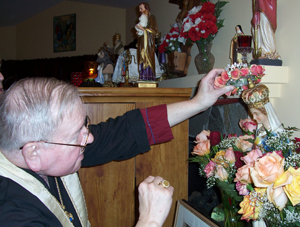
In 1963, Francis Schuckardt once again found himself in the hospital, this time with the prospect of leg amputation due to infection. "Dear Mother, if you will save my legs... I will use them to travel and to extend the cell program wherever you want me to go." Again, Our Lady answered his prayers and he traveled extensively promoting the Fatima cell program as promised. That same year he was elected to the International Council of the Blue Army, at the age of 26, a first for someone who had not been a national head of the organization.2
In the late 1960's, however, things began to change. As the Blue Army embraced the sweeping changes coming out of Vatican Council II, Francis Schuckardt in conscience could not and so he found it necessary to quit the organization.3
Separation from the Modern "Catholic" ChurchAbout the time of his departure from the Blue Army, he began giving lectures throughout the United States, speaking out against the various doctrinal changes that were the result of the Vatican Council II, as well as trying to spread devotion to the Mother of God.
After a long and agonizing struggle, accompanied by much prayer and research, Francis Schuckardt finally came to the conclusion that the "new" Church that emerged from this Council was no longer truly "Catholic." While there were many things which drew him to this conclusion, three items in particular especially convinced him:
a) False Popes
Francis Schuckardt concluded that Paul VI was a false pope. He based this theory upon what he said was the only logical conclusion to be drawn from the Catholic Church's dogma on papal infallibility, which states that when a pope speaks "ex cathedra" (officially as pope) and "defines a doctrine concerning faith and morals to be held by the whole church," that such doctrine is infallible and must be believed by all Catholics. Francis Schuckardt argued that all the popes, from St. Peter through Pius XII, taught one set of doctrines on faith and morals, and that the popes since Vatican Council II have taught a different set up doctrines. He further reasoned that popes exercising papal infallibility cannot possibly contradict one another in matters of faith and morals, and that in applying the doctrine of papal infallibility to the situation at hand, only one plausible explanation could be found for the contradictory doctrines being taught by the post-Vatican Council II popes, i.e., that they could not be true popes
He also argued that since logic does not allow for two contradictory things to exist at the same time in the same entity (light and darkness, heat and cold, ...), that you could not have true popes infallibly teaching contradictory doctrines (it is also an infallible teaching of the Catholic Church that doctrines can not change with time, but rather remain forever fixed); someone had to be wrong!
So in logically applying the doctrines of papal infallibility and doctrinal immutability, he concluded that either the first 261 popes were true popes and the recent few were not, or vice versa, or none of them were true popes. These were the only three possibilities. Since Christ Himself appointed St. Peter, he was obviously a true pope. And since the 260 that followed after St. Peter taught the same doctrinal teaching on matters of faith and morals, they too must be true popes. That left the post-Vatican Council II popes out of the equation of being true popes.
b) Invalidity of the New Mass
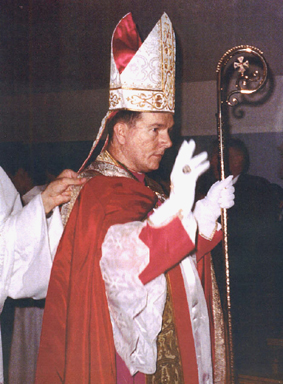
One of the most sweeping changes introduced by Vatican Council II was to change the sacrificial character of the Mass. To Catholics, the Mass is the heart of our faith. Catholics believe that every Mass is the unbloody reenactment of the Crucifixion of Christ on Mt. Calvary; that at every Mass Christ is really offered up again for the salvation of mankind.
When the New Mass was promulgated in 1969, it was defined in a General Instruction in this way: “The Lord’s Supper or Mass is the sacred assembly or congregation of the people of God gathering together, with a priest presiding, to celebrate the memorial of the Lord.” This new definition agrees with Protestant theology, which has always denied the sacrificial character of the Mass.
The Sacrifice of the Mass necessarily contains the Sacrament of the Holy Eucharist. The Church has infallibly declared that for every sacrament to be valid (actually takes place and confers grace) there has to be proper matter, form, and intention. If any of these three elements is absent or notably changed, there is no sacrament.
Vatican Council II changed part of the form of the sacrament of the Eucharist (at the “Consecration of the wine”). Among other changes, the words "for you and for many" were replaced with "for you and for all" (referring to the shedding of Christ’s Blood). Before Vatican II, every Missale Romanum (Latin Mass book) contained a decree (De Defectibus), which states: “But if someone omits or changes something in the form of the consecration of the Body and Blood, and in this changing of the words they do not signify the same thing, the Sacrament is not confected” (i.e., is not valid).
The question is whether the change to “for all” really changes the meaning. But this question was answered hundreds of years ago. The Catechism of the Council of Trent states, in the section on the Holy Eucharist: “With great propriety therefore, were the words, for all, omitted, because here the fruit of the Passion is alone spoken of, and to the elect only did His Passion bring the fruit of salvation.” It is truly remarkable that the New Mass uses the very words rejected by the Catechism. This point is made clearer if we imagine the same change in other Sacraments: I baptize you and all men… I absolve you and all men…I take you and all men for my lawful wedded husband… Obviously, none of these would be valid Sacraments.
As to valid intention, the consistent teaching of the Church is that it suffices to intend to do what the Church does. However, when Pope Leo XIII declared that the sacrament of holy orders was invalid in the Anglican Church, He stated: “…if the rite be changed, with the manifest intention of introducing another rite not approved by the Church and of rejecting what the Church does, and what by the institution of Christ belongs to the nature of the sacrament, then it is clear that not only is the necessary intention wanting to the sacrament, but that the intention is adverse to and destructive of the sacrament.” A priest saying the New Mass, who has the intention of merely presiding over the assembly in a “memorial of the Lord,” would not, therefore, have a valid intention, and consequently, there would be no sacrament.
c) False Ecumenism of Vatican II
The keynote of Vatican II and the thrust of its doctrinal changes is the new “ecumenism” or movement to promote “unity” amongst various religions. Bishop Schuckardt and many others recognized this ecumenism as false, and indeed heretical. In His Encyclical Mortalium Animos (On True Christian Unity), Pope Pius XI lamented that “…congresses, meetings, and addresses are arranged, attended by a large concourse of hearers, where all without distinction, unbelievers of every kind as well as Christians, even those who unhappily have rejected Christ and denied His Divine Nature or mission, are invited to join in the discussion. Now, such efforts can meet with no kind of approval among Catholics. They presuppose the erroneous view that all religions are more or less good and praiseworthy, inasmuch as all give expression, under various forms, to that innate sense which leads men to God and to the obedient acknowledgment of His rule. Those who hold such a view are not only in error; they distort the true idea of religion, and thus reject it, falling gradually into naturalism and atheism. To favor this opinion, therefore, and to encourage such undertakings is tantamount to abandoning the religion revealed by God.” Vatican Council II does precisely what Pope Pius XI lamented. The whole of the Council’s Decrees on Ecumenism and on Non-Christian Religions proclaim the very errors condemned by Pope Pius XI and many other past Popes and Councils.
In the same Encyclical Pope Pius states: "And here it will be opportune to expound and to reject a certain false opinion which lies at the root of this question and of that complex movement by which non-Catholics seek to bring about the union of 'Christian' Churches. Those who favor this view constantly quote the words of Christ, That they may be one... And there shall be one fold, and one shepherd (John 17:21, 10:l6), in the sense that Christ thereby merely expressed a desire or a prayer which as yet has not been granted. For they hold that the unity of faith and government, which is a note of the one true Church of Christ, has up to the present time hardly ever existed, and does not exist today. They consider that this unity is indeed to be desired and may even, by cooperation and goodwill, be actually attained, but that meanwhile it must be regarded as a mere ideal. The Church, they say, is of its nature divided into sections, composed of several churches or distinct communities which still remain separate..." All "popes" since Vatican Council II, John Paul II being the most noteworthy, have promulgated this very error. While still Archbishop of Krakow, Karol Wojtyla wrote a book on implementing the decrees of Vatican II in his diocese. In Chapter 4 of Sources of Renewal, Wojtyla states: "...ecumenical action and a truly ecumenical attitude can be born only of the hope, that, although the Church is divided by men, in the mind and will of Christ it is one and undivided" (emphasis added).
In short, the clear teaching of the Catholic Church, from the time of the Apostles until the death of Pope Pius XII, has been consistently the same: there is no salvation outside of the Catholic Church.
Reaction of Post-Vatican II Church
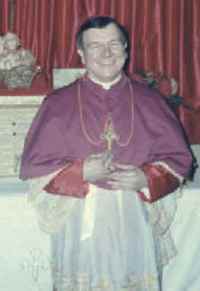 Many
in the modern "Catholic" Church did not appreciate being exposed for
introducing and adhering to non-Catholic doctrines and so used their
considerable influence and power to silence Bishop Schuckardt.
Their inability to successfully challenge him in the arena of Catholic
doctrine without running the risk of exposing themselves for abandoning
the true teachings of the Catholic Church, made them opt for another
tried and true method of dealing with one's adversary - attack the
messenger in an attempt to bury his message. This organization of over 1
billion people worldwide has used its considerable resources to that
end for nearly 40 years, sadly with great success. But the Bishop
can find comfort in the teachings of Christ: "If the world hates you,
know that it has hated me before you."
Many
in the modern "Catholic" Church did not appreciate being exposed for
introducing and adhering to non-Catholic doctrines and so used their
considerable influence and power to silence Bishop Schuckardt.
Their inability to successfully challenge him in the arena of Catholic
doctrine without running the risk of exposing themselves for abandoning
the true teachings of the Catholic Church, made them opt for another
tried and true method of dealing with one's adversary - attack the
messenger in an attempt to bury his message. This organization of over 1
billion people worldwide has used its considerable resources to that
end for nearly 40 years, sadly with great success. But the Bishop
can find comfort in the teachings of Christ: "If the world hates you,
know that it has hated me before you."
As part of their effort to disparage Bishop Schuckardt, some in post-Vatican II Catholic Church condemn him and declare him to be both schismatic and excommunicated. But as Bishop Schuckardt does not acknowledge the post-Vatican II Catholic Church, officially or unofficially, and dismisses any charges of schism or excommunication by them. Because he considers them to be a new and different Church, and not the Catholic Church founded by Christ that existed for nearly 2,000 years, he rejects the notion that they have the authority to excommunicate him or declare him schismatic from the "true" Catholic Church. As far as being excommunicated or declared schismatic from their "new Church," he finds that claim to be ludicrous because he has never been a member of the post-Vatican Council II Catholic Church.
Fatima Crusade and the CMRI
In 1967, Francis Schuckardt started a lay organization called the Fatima Crusade in Coeur d’Alene, Idaho. This organization was intended to serve the twofold purpose of spreading the message of Our Lady of Fatima as well as the preservation of traditional Catholicism. Many of the "Fatima Crusaders," as they later became known, wanted to dedicate themselves more completely to God and besought Francis to establish a religious congregation to meet their wishes.
So in 1967, on the feast of Our Lady of the Snows, Francis Schuckardt, with the approbation of Bishop Treinen of Boise, founded the Congregation of Mary, Immaculate Queen of the Universe (in Latin: Congregatio Mariae Reginae Immaculatae; hence, CMRI for short). At this time there were no priests in the Religious Congregation, but there were some traditional-minded priests who would provide the Fatima Crusade with the traditional Catholic Sacraments and offer for them the Tridentine Latin Rite Mass. The new Mass was not allowed. Brother Francis Schuckardt, however, realized the necessity of having a bishop to ensure Apostolic Succession in the traditional Catholic Church, and had to address this problem somehow.
Ordination and Consecration
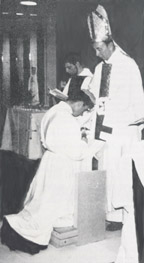 In 1969, Daniel Quilter Brown received Episcopal consecration as an “Old Roman Catholic” bishop.4
Bishop Brown had been born and raised a Catholic, but became
disenchanted with the reforms of Vatican II and had chosen to become an
Old Roman Catholic bishop in order to perpetuate valid Episcopal orders;
realizing that the Old Roman Catholics, unlike the modern
post-Conciliar Catholic Church, had not yet fallen into heresy and thus
still retained valid Orders.5
Despite the fact that Bishop Brown obtained his consecration in
the Old Roman Catholic Church (a schismatic church), he and his
followers called themselves Roman Catholics and refused to use the title
of "Old Roman Catholic." Shortly after his consecration, he broke all
ties and communications with the Old Roman Catholics.6
Bishop Brown soon became acquainted with Brother Francis and
tried to persuade him to accept ordination from him, because "in view of
the fact that we cannot exist for long as Catholics without the
sacraments, I would propose to ordain to the priesthood a qualified
member of your group (from the information I have, this would probably
be yourself)..."7
Later he proposed to consecrate Brother Francis to the episcopacy in addition to ordaining him to the priesthood.
In 1969, Daniel Quilter Brown received Episcopal consecration as an “Old Roman Catholic” bishop.4
Bishop Brown had been born and raised a Catholic, but became
disenchanted with the reforms of Vatican II and had chosen to become an
Old Roman Catholic bishop in order to perpetuate valid Episcopal orders;
realizing that the Old Roman Catholics, unlike the modern
post-Conciliar Catholic Church, had not yet fallen into heresy and thus
still retained valid Orders.5
Despite the fact that Bishop Brown obtained his consecration in
the Old Roman Catholic Church (a schismatic church), he and his
followers called themselves Roman Catholics and refused to use the title
of "Old Roman Catholic." Shortly after his consecration, he broke all
ties and communications with the Old Roman Catholics.6
Bishop Brown soon became acquainted with Brother Francis and
tried to persuade him to accept ordination from him, because "in view of
the fact that we cannot exist for long as Catholics without the
sacraments, I would propose to ordain to the priesthood a qualified
member of your group (from the information I have, this would probably
be yourself)..."7
Later he proposed to consecrate Brother Francis to the episcopacy in addition to ordaining him to the priesthood.
Brother Francis sought the advice of some traditional Catholic priests, most notably Fr. Burton Fraser, S.J., about Bishop Brown's proposal. He was told that under the grave circumstances that currently existed, that it was well within Catholic law and principles to accept consecration. Although the Catholic Church acknowledges the validity of Old Catholics orders, Brother Francis was unwilling to receive orders from Bishop Brown because of the schismatic origins of his consecration.
In the meantime, Bishop Brown openly repented of having received consecration from the Old Roman Catholics, broke all ties with them, made a public "Abjuration of Error and Profession of Faith", confessed his sins and received absolution from a traditional priest.8 It was only after these events that Brother Francis agreed to receive consecration from Bishop Brown: "[T]hese past months have been spent in intense soul searching and continuous prayer to know and follow God's holy will. Thus I could not give you a reply until I felt fairly certain in my heart and mind. Now, finally, in concluding our novena in honor of the Annunciation, I have come to a decision. It is with holy trepidation that I accept your offer..."9
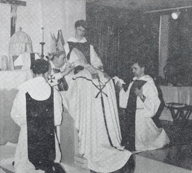
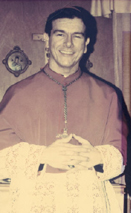 On
October 28, 1971, in the presence of some loyal Fatima Crusaders,
Bishop Brown tonsured and bestowed the four Minor Orders on Francis
Schuckardt. On October 29, 1971, Bishop Brown conferred the Major Orders
of Subdeacon and Deacon upon him. On October 31, 1971, Bishop
Brown ordained Francis Schuckardt to the priesthood, and on November 1,
1971, the Feast of All Saints, Bishop Brown consecrated Fr. Francis
Schuckardt a bishop according to the traditional Roman Catholic Rite.10
The fact of his consecration and the source of his Episcopal
orders were announced publicly on December 8, 1971. He celebrated
his first public Mass for the Fatima Crusade at Mary, Immaculate Queen
Church in northern Idaho on December 12, 1971. All but a tiny
fraction of the Fatima Crusade accepted his consecration.
On
October 28, 1971, in the presence of some loyal Fatima Crusaders,
Bishop Brown tonsured and bestowed the four Minor Orders on Francis
Schuckardt. On October 29, 1971, Bishop Brown conferred the Major Orders
of Subdeacon and Deacon upon him. On October 31, 1971, Bishop
Brown ordained Francis Schuckardt to the priesthood, and on November 1,
1971, the Feast of All Saints, Bishop Brown consecrated Fr. Francis
Schuckardt a bishop according to the traditional Roman Catholic Rite.10
The fact of his consecration and the source of his Episcopal
orders were announced publicly on December 8, 1971. He celebrated
his first public Mass for the Fatima Crusade at Mary, Immaculate Queen
Church in northern Idaho on December 12, 1971. All but a tiny
fraction of the Fatima Crusade accepted his consecration.
At first Bishops Brown and Schuckardt worked peaceably together. Shortly afterwards, Bishop Brown saw "splinter groups" forming and desired that Bishop Schuckardt lead the Church. In writing to Bishop Schuckardt, Bishop Brown deemed it "urgent that these people be united into one body with one leader who would be, logically, yourself."11 Eventually, however, differences broke out between them and they separated and went their own ways. Bishop Brown eventually returned to the Old Catholic Church.
Traditional Catholic Community and the TLRCC
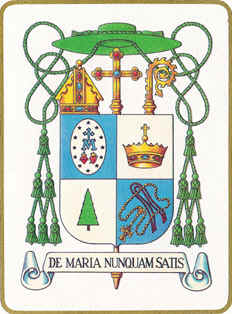 Bishop
Schuckardt and the Fatima Crusade have always considered themselves to
be Catholics and part of the "true" Catholic Church as it has existed
since the time of Christ. The Catholic Church teaches that being a
Catholic requires three things: 1) Baptism; 2) profession of the truths
of the Faith; and 3) lawful communion of the Church.12
At no time has the Catholic Church ever placed the condition of
membership in the Church upon anything else. "He that believeth and is
baptized shall be saved: but he that believeth not shall be condemned."
(Mark 16:16) Membership in the Catholic Church is not contingent
upon the possession of church buildings, large numbers of adherents, or
any of the externals normally associated with the Catholic Church; it
boils down to a set of core beliefs and baptism.
Bishop
Schuckardt and the Fatima Crusade have always considered themselves to
be Catholics and part of the "true" Catholic Church as it has existed
since the time of Christ. The Catholic Church teaches that being a
Catholic requires three things: 1) Baptism; 2) profession of the truths
of the Faith; and 3) lawful communion of the Church.12
At no time has the Catholic Church ever placed the condition of
membership in the Church upon anything else. "He that believeth and is
baptized shall be saved: but he that believeth not shall be condemned."
(Mark 16:16) Membership in the Catholic Church is not contingent
upon the possession of church buildings, large numbers of adherents, or
any of the externals normally associated with the Catholic Church; it
boils down to a set of core beliefs and baptism.
Bishop Schuckardt and the Fatima Crusaders believe that the church that came out of Vatican Council II is a new church, with a new set of beliefs, doctrines and liturgy; and is consequently no longer truly Catholic. This new church, however, still calls itself Catholic, as does Bishop Schuckardt and the members of the Fatima Crusade, and this has led to confusion even to this day.
For example, when the Fatima Crusade sought to purchase real estate for their growing Church, putting their properties under the title of "Catholic Church" would have resulted in the loss of those properties to the Vatican II Church. Confusion also ensued when the members of the Fatima Crusade simply used the term "Catholic" to describe themselves, as people immediately associated them with the post-Vatican II Catholic Church. When the post-Vatican II Catholic Church correctly denied that the Fatima Crusade was affiliated with them, some would accuse the Fatima Crusade of deceit, of trying to pawn themselves off as members of the post-Vatican II Church. These and other problems necessitated the use of a different name, but one which adequately expressed the beliefs of the Fatima Crusade. Since one of the hallmarks of the Fatima Crusade was the retention of the Tridentine Latin Rite Mass as promulgated and set in perpetuity by Pope St. Pius V, the name Tridentine Latin Rite Catholic Church (TLRCC) was chosen. The enemies of the TLRCC found opportunity, in the adoption of this name, to falsely accuse the TLRCC of being a new church.
During the autumn of 1972, Bishop Schuckardt received the Last Rites in Coeur d’Alene, Idaho, due to a gangrenous intestine; he survived, but his already precarious health had been further compromised.[13]
Between 1975 and 1979 he then ordained Denis Chicoine and a handful of others to the priesthood. Some were sent out as missionaries and but most stayed to provide for the ever growing needs of the TLRCC.
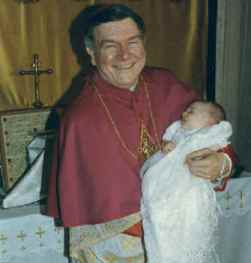 The
TLRCC grew at a rapid pace. By 1977, this Church became so large
that it was found necessary to purchase a large former Jesuit seminary
in Spokane, Washington - Mount Saint Michael. The 735 acre
facility with over 200 rooms, complete with a gymnasium and swimming
pool, was used as a church, seminary, boys school, retreat center, print
shop and bookstore. The movement continued to grow, eventually
sending priests to various parts of the world, including Canada, Mexico,
Australia, New Zealand and the Holy Land. By 1984, Bishop
Schuckardt had transformed the original little group of Brothers and
Sisters who started in 1967 into a thriving and bustling Traditional
Catholic community. The Tridentine Latin Rite Catholic Church
numbered about 120 Sisters, 6 active priests, 61 Clerics and Brothers, K
- 12th grade boys and girls school, the Knights of the Eucharist, the
Knights of the Altar, the Knights of St. Karl the Great, the Altar and
Rosary Society, Our Lady of Cana Cell for couples interested in
courtship and marriage, the Holy Name Ushers, several Third Orders,
numerous Fatima Cells, St. Anne's Home for the elderly and infirm, the
Little Daughters of the Immaculate Conception Convent for the mentally
impaired, the Singing Nuns, the Kevelaer School for the neurological
impaired, the St. Joseph the Worker Guild, the Mater Dolorous
Guild to aid the terminally ill and arrange for their funerals, etc.14
In addition to Mt. St. Michael's, they also owned over 18 other properties, collectively worth millions of dollars.15
The
TLRCC grew at a rapid pace. By 1977, this Church became so large
that it was found necessary to purchase a large former Jesuit seminary
in Spokane, Washington - Mount Saint Michael. The 735 acre
facility with over 200 rooms, complete with a gymnasium and swimming
pool, was used as a church, seminary, boys school, retreat center, print
shop and bookstore. The movement continued to grow, eventually
sending priests to various parts of the world, including Canada, Mexico,
Australia, New Zealand and the Holy Land. By 1984, Bishop
Schuckardt had transformed the original little group of Brothers and
Sisters who started in 1967 into a thriving and bustling Traditional
Catholic community. The Tridentine Latin Rite Catholic Church
numbered about 120 Sisters, 6 active priests, 61 Clerics and Brothers, K
- 12th grade boys and girls school, the Knights of the Eucharist, the
Knights of the Altar, the Knights of St. Karl the Great, the Altar and
Rosary Society, Our Lady of Cana Cell for couples interested in
courtship and marriage, the Holy Name Ushers, several Third Orders,
numerous Fatima Cells, St. Anne's Home for the elderly and infirm, the
Little Daughters of the Immaculate Conception Convent for the mentally
impaired, the Singing Nuns, the Kevelaer School for the neurological
impaired, the St. Joseph the Worker Guild, the Mater Dolorous
Guild to aid the terminally ill and arrange for their funerals, etc.14
In addition to Mt. St. Michael's, they also owned over 18 other properties, collectively worth millions of dollars.15
Revolt
Bishop Schuckardt had recognized early on that Vatican Council II, and the resultant loss of faith that followed, did not happen in a vacuum. He believed this event was a punishment from God, as predicted in many prophecies, and the end result of centuries of compromises between many in the Catholic Church and the forces of evil that oppose it. He felt it incumbent upon himself to practice and teach Catholicism "in its fullness," without compromising any of the teachings of the Church or watering down the truths of the Faith. This meant more than simply turning back the clock to pre-Vatican II days, it meant implementing all of the teachings of the past popes, Church Councils, and of the Church father, doctors, and saints.
This was considered to be radical by most people, who grew up in a Church where total Catholicism was never demanded of them. Many quietly rebelled and complained to Chicoine and his associates about this no-compromise implementation of Catholicism. They wanted to attend a Latin Mass on Sunday and to be like "worldlings" the rest of the week. The Bishop, however, would not compromise.
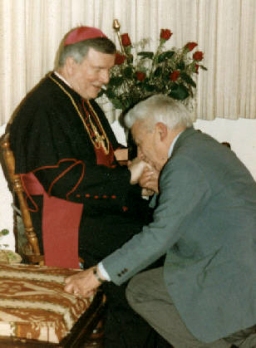 Adding
fuel to this discontent was the fact that Bishop Schuckardt had long
suffered from physical ailments and Episcopal ceremonies were more
frequently being delayed or cancelled. Church members got tired of
waiting for him to show up for ceremonies and started to grumble.
His personal illness and his dissatisfaction in the candidates for the
priesthood had brought ordinations essentially to a standstill, much to
the discontent of the want-to-be-priests. The local media also
started to attack Bishop Schuckardt and the Fatima Crusade about this
time. Many of the clergy and laity alike were becoming more and
more dissatisfied and started to plot his overthrow. After
secretly canceling all public Sunday Masses except for one, Chicoine
took to the podium during that only Mass on May 27, 1984 and launched
into what was to become one of many tirades against Bishop
Schuckardt. When Chicoine took the offensive against Bishop
Schuckardt and found that he had the backing of the vast majority of the
Religious and laity alike, he immediately took charge of the Fatima
Crusade.
Adding
fuel to this discontent was the fact that Bishop Schuckardt had long
suffered from physical ailments and Episcopal ceremonies were more
frequently being delayed or cancelled. Church members got tired of
waiting for him to show up for ceremonies and started to grumble.
His personal illness and his dissatisfaction in the candidates for the
priesthood had brought ordinations essentially to a standstill, much to
the discontent of the want-to-be-priests. The local media also
started to attack Bishop Schuckardt and the Fatima Crusade about this
time. Many of the clergy and laity alike were becoming more and
more dissatisfied and started to plot his overthrow. After
secretly canceling all public Sunday Masses except for one, Chicoine
took to the podium during that only Mass on May 27, 1984 and launched
into what was to become one of many tirades against Bishop
Schuckardt. When Chicoine took the offensive against Bishop
Schuckardt and found that he had the backing of the vast majority of the
Religious and laity alike, he immediately took charge of the Fatima
Crusade.
With Bishop Schuckardt out of the way, Chicoine started to systematically do away with many of the practices and beliefs that constituted the Fatima Crusade. Religious left by the droves and Church membership sharply declined. In an attempt to justify their takeover, they launched a smear campaign to vilify Bishop Schuckardt and those that remained loyal to him. They find it necessary to continue this smear campaign even to this day, in order to justify their retention of the spoils of the Church that Bishop Schuckardt built and as well as to justify their rejection of those Catholic truths and practices they once professed. Many of these people have become hostile and the accusations seem to be without number. Contrary to the propaganda these people put out, Bishop Schuckardt and the TLRCC are not afraid to answer these accusations. Therefore they are included here along with the TLRCC's responses for the reader to see and to judge for themselves.
Accusations
These accusations are directly copied from sources hostile to Bishop Schuckardt and the TLRCC: Some former members have called the TLRCC a destructive cult. They assert that TLRCC members were systematically cut off from the rest of society and have been programmed to obey the commands of church leaders or risk losing their souls. They assert that the TRLCC regarded the outside world as inherently evil and that members were required to sever ties with family members who did not belong to the Church, even if breaking up a marriage was necessary. They claim that books, both religious and secular, were confiscated from members and only books approved by Schuckardt were allowed. In addition, subscriptions to secular newspapers and magazines as well as owning a television were banned. They claim that books sold in the church bookstore were also modified; whole pages were removed, or lines of text were pasted over with strips of paper when found objectionable by Schuckardt and other Church leaders. Further, publishers' names and addresses were removed or covered over to prevent members from ordering books directly.
Some former members also claim that everyone was required to send their children to the TLRCC schools. They claim that there were instances of criminal prosecutions against school staff for excessive disciplining. On October 26, 1976, for example, a religious teacher in the school, Paul Welsh, was sentenced to serve five days in jail in Kootenai County, Idaho for excessive spanking of a 10-year old student. They claim that verbal abuse was also commonly used in addition to physical abuse. Other charges were: That Schuckardt had imposed arbitrary and fanatical rules. That the dress code for women was unusually strict, even by traditionalist's Catholic standards, with women required to have their heads covered not only in Church, but at all times. That smoking was a gravely sinful vice. That everyone was required to wear a rosary around their neck, over their clothes where everyone could see it. That information and books from the outside world were carefully censored, to the point that nuns would cut and paste over sections of Dick and Jane books that were considered taboo. That men and women were obliged to sit on opposite sides of the aisle at church. That members were expected to walk backwards out of church when no Catholic parish or religious order before or since has ever imposed such a rule. That he discouraged his followers from allowing their children to attend college. That he prohibited his flock from watching television, although he watched TV news, pop culture and politics. That his ordained followers were ordered in many cases to become flagellants or other cases of mortification of the flesh. That Schuckardt began sexually seducing his seminarians and religious men. Finally, that Schuckardt was preparing to declare himself Pope Hadrian VII and had began certain practices of popes, such as wearing a white cassock on occasion and demanding that his close associates accord him papal honors.
Chicoine Faction Became Schismatic
Those loyal to Bishop Schuckardt charge the Chicoine faction with schism.16 The Catholic Church is a divinely constituted hierarchical institution, and there are no provisions in Church law17 whereby an ecclesiastical inferior [herein a priest] can depose an ecclesiastical superior [herein a bishop], except by having recourse to someone further up in the hierarchy. Since both Bishop Schuckardt and Rev. Chicoine acknowledged no higher Church authority than Bishop Schuckardt himself,18 there was no means whereby Rev. Chicoine could depose him. The Chicoine faction was unwilling to tolerate Bishop Schuckardt, so they delegated to themselves the authority of being Bishop Schuckardt’s ecclesiastical superior and then played the role of accuser, prosecutor, judge and jury, and awarded to themselves the Tridentine Latin Rite Catholic Church and all of its assets without trial.19 Those remaining loyal to Bishop Schuckardt also claim that in order for the Chicoine faction to win the support of so many Church members, they engaged in calumny and detraction20 (which the Catholic Church declares to be a serious sin), and that those loyal to Bishop Schuckardt were seriously disadvantaged inasmuch as they would not meet them in kind.
Answers to Accusations and Counterclaims
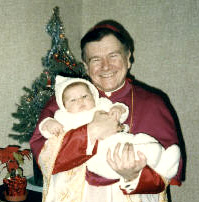 The
TLRCC claims that the charges against the Bishop were a subterfuge to
mask the real reason for the Chicoine faction's revolution. They claim
that it was common knowledge within Bishop Schuckardt's inner circle and
well known to the Chicoine faction that the Bishop found Chicoine and
his adherents to be both incompetent and untrustworthy, and that
consequently he was about to have them demoted or replaced. They state
that Chicoine and his adherents were not willing to accept this
humiliation and that they saw an opportunity in the Bishop's
illness-induced absence not only to keep their positions, but also to
gain control of a well-established Church worth millions of dollars. The
TLRCC claims that it was lust for power and primal greed that primarily
spawned the revolution; and that coupled with the widespread
dissatisfaction of many members over having to live lives of strict,
uncompromising Catholicism, Church members were eager for change and
readily accepted Chicoine's accusations without question.
The
TLRCC claims that the charges against the Bishop were a subterfuge to
mask the real reason for the Chicoine faction's revolution. They claim
that it was common knowledge within Bishop Schuckardt's inner circle and
well known to the Chicoine faction that the Bishop found Chicoine and
his adherents to be both incompetent and untrustworthy, and that
consequently he was about to have them demoted or replaced. They state
that Chicoine and his adherents were not willing to accept this
humiliation and that they saw an opportunity in the Bishop's
illness-induced absence not only to keep their positions, but also to
gain control of a well-established Church worth millions of dollars. The
TLRCC claims that it was lust for power and primal greed that primarily
spawned the revolution; and that coupled with the widespread
dissatisfaction of many members over having to live lives of strict,
uncompromising Catholicism, Church members were eager for change and
readily accepted Chicoine's accusations without question.
The TLRCC also claim that many of the charges against them are outright false and others are rooted in crass ignorance of the actual teachings and customs of the Catholic Church and answer the charges in summary here below:
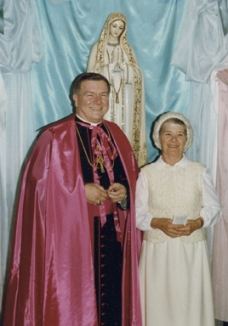 The
dress code "by traditionalists' standards" was strict, but the dress
code was not based upon "traditionalists' standards" but upon compliance
with the standards set forth by Pope Pius XI 22
and Pope Pius XII regarding "Mary-like" standards of modesty, as well
as an attempt to answer Our Lady of Fatima's plea for reparation for the
sins of man, of which she said that sins of flesh were damning more
souls to Hell than any other sin.23
The
dress code "by traditionalists' standards" was strict, but the dress
code was not based upon "traditionalists' standards" but upon compliance
with the standards set forth by Pope Pius XI 22
and Pope Pius XII regarding "Mary-like" standards of modesty, as well
as an attempt to answer Our Lady of Fatima's plea for reparation for the
sins of man, of which she said that sins of flesh were damning more
souls to Hell than any other sin.23
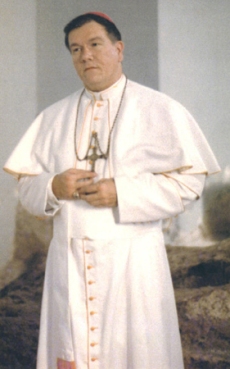 Bishop
Schuckardt denies that he ever declared himself to be the pope. Some of
his followers, however, believe him to be so based upon their belief
that he is the "last true Catholic bishop" in the world and upon the
teaching of the Catholic Church that the Church must have a pope,42
except during periods of interregnum.43
Bishop
Schuckardt denies that he ever declared himself to be the pope. Some of
his followers, however, believe him to be so based upon their belief
that he is the "last true Catholic bishop" in the world and upon the
teaching of the Catholic Church that the Church must have a pope,42
except during periods of interregnum.43
Exile
Not long after Rev. Chicoine's revolt, Bishop Schuckardt, in fear for his safety,45 left the area with a small handful of followers. They finally settled in Greenville, California. Members moved into several homes in the area and picked up where they had left off, but not before Bishop Schuckardt formally excommunicated Chicoine and a handful of others working in consort with him.46 Bishop Schuckardt's group continued to operate as the Tridentine Latin Rite Catholic Church while the Chicoine faction started a new church and incorporated it on June 14, 1984, as the Latin Rite Catholic Church.47
Unknown to the Schuckardt faction, the Chicoine faction sued them, alleging they took property belonging to the Chicoine faction. They obtained a default judgment against Bishop Schuckardt's group for $250,000.00 as well as an injunction barring them from Fatima Crusade properties. (Case 84-2-01445-2). The Default Judgment was challenged by Bishop Schuckardt’s group in 1988 and successfully overturned for Bishop Schuckardt and most of his followers.48
Rejection of other "Traditionalists"
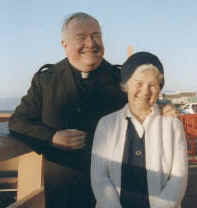 In
1985, Rev. Chicoine and two of the other three priests of Mount Saint
Michael were "conditionally ordained" as priests by a Bishop George
Musey. Bishop Musey himself stated his belief that these three
priests (Rev. Chicoine, Rev. McGilloway, Rev. Hughes) had been validly
ordained by Bishop Schuckardt, but was conditionally ordaining them to
appease the doubts of some.49
Rev. Musey’s episcopal lineage descended from Bishop Thuc.
Bishop Musey had been associated with the autocephalous Traditional
Byzantine Rite Church, and had several ties to the Old Catholics.
Bishop Schuckardt's group challenges the validity of Bishop Musey’s
consecration;50
condemns him for impeding upon Bishop Schuckardt’s jurisdiction;51
condemns him for conditionally ordaining against Church law people who
have been sentenced with a declaratory and condemnatory sentence of
excommunication;52
and for other reasons.
In
1985, Rev. Chicoine and two of the other three priests of Mount Saint
Michael were "conditionally ordained" as priests by a Bishop George
Musey. Bishop Musey himself stated his belief that these three
priests (Rev. Chicoine, Rev. McGilloway, Rev. Hughes) had been validly
ordained by Bishop Schuckardt, but was conditionally ordaining them to
appease the doubts of some.49
Rev. Musey’s episcopal lineage descended from Bishop Thuc.
Bishop Musey had been associated with the autocephalous Traditional
Byzantine Rite Church, and had several ties to the Old Catholics.
Bishop Schuckardt's group challenges the validity of Bishop Musey’s
consecration;50
condemns him for impeding upon Bishop Schuckardt’s jurisdiction;51
condemns him for conditionally ordaining against Church law people who
have been sentenced with a declaratory and condemnatory sentence of
excommunication;52
and for other reasons.
Bishop Schuckardt and the TLRCC have consistently questioned the validity of the orders conferred by other "traditionalists," namely Archbishop Lefebvre and Bishop Thuc. The very fact that neither of these two ever publicly renounced Vatican Council II is one of the chief reasons why the validity of their orders are doubtful.
Rev. Chicoine died on August 10, 1995. He reportedly had a change of heart on his deathbed and lamented rebelling against Bishop Schuckardt. His excommunication was still in effect at the time of his death.
Arrests and Legal Wrangling
On May 9, 1987, a California SWAT team executed a search warrant of the houses where Bishop Schuckardt and his faithful Religious were living. The Chicoine faction misled the Californian authorities into believing that they would find automatic weapons if they searched these homes, which was why a SWAT team was called up. None were found.
Bishop Schuckardt and 13 of his followers were arrested for possession of stolen property, i.e., property they took with them when they left Spokane. In addition Bishop Schuckardt was accused of unlawful possession of a controlled substance, i.e. prescription drugs for which the original prescriptions could not be found.53 Bishop Schuckardt accepted a plea bargain of attending a one-day diversion class in exchange for all charges being dismissed against him.54 All charges against the other 13 were dismissed without prejudice55 and all the property seized by the sheriff's office was returned to them, the judge ruling that it was not a criminal issue. Following their dismissals, the 13 then successfully obtained a Declaration of Factual Innocence and had their criminal arrests erased from their records.56
Immediately after the arrests of Bishop Schuckardt's group, the Chicoine faction filed two civil suits 57 in California to obtain all the property the Sheriff's Office had seized as "stolen property", but neither was successful. They further filed civil actions against the Bishop Schuckardt group in Utah,58 Arizona,59 and Canada,60 but lost all of these cases as well.
The Bishop Schuckardt group then filed a Federal Civil Rights Suit against the Sheriff's Department and the County for violation of their civil rights in the U.S. District Federal Court. At a settlement conference presided over by Chief Justice Karlton, the County agreed to pay an undisclosed, but significant sum of money to keep the case from going to trial.
Bishop Schuckardt's group also challenged the civil suit61 filed by the Chicoine faction in Washington in 1984 and agreed to a settlement in 1994.
After receiving death threats in California, and suffering significant vandalism at the Brothers' residence, Bishop Schuckardt moved the headquarters of his group to the Seattle, Washington area.
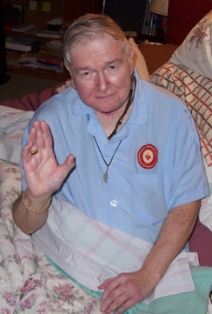 Epilogue
Epilogue
For over 40 years, Bishop Schuckardt has dedicated his life to preserving the Catholic Faith, whole, inviolate, and without compromise; and to spreading devotion to the Mother of God. His has given thousands of sermons and lectures to this end. It would be hard, if not impossible, to find a sermon or talk given by him in which he did not try to get his listeners to lead lives more pleasing to God and to achieve that all important task for which God has created us: the salvation of our immortal souls, through the intercession of the Most Blessed Virgin Mary. For this he has received nothing but grief and animosity from nearly everyone. People don't like to be told that their lives are not pleasing to God and that amendment of life, as asked for by Our Lady of Fatima, in necessary. Yet despite that, he has never wavered from the promise he made as a young man to the Mother of God, to spend his life in doing her work for the spiritual benefit of mankind.
REQUIESCAT IN PACE
MAY HE REST IN PEACE
On November 5, 2006, His Excellency, the Most Reverend Bishop Francis K. Maria Schuckardt of the Immaculate Heart of Mary, departed this life and entered into eternity.
His Excellency had been diagnosed with terminal cancer in April, 2006. His spent his remaining days in first providing for the needs of the Tridentine Latin Rite Catholic Church, principally by consecrating two bishops, and then by personally preparing himself for his own death.
Although very ill, he attended Holy Mass and received Holy Communion daily in the small chapel in his house for several months. When he became too ill to leave his bed, daily Mass was offered in his room and he continued to faithfully receive Holy Communion every day until the day he died. He received the Last Rites with devotion as well as the Apostolic Benediction, to which is attached a plenary indulgence applicable at the moment of death (i.e., the punishment due for all forgiven sin is remitted at the moment of death). He also faithfully applied himself to fervent prayer; especially the Holy Rosary and various other prayers enriched with plenary indulgences.
On the morning of November 5, while the Rosary was being prayed in his room, he peacefully took his last breath and received one final absolution. This devotee of Our Lady departed this life wearing her Brown Scapular, a sacramental which he has never been without since his youth.
Although suffering terribly from the ravages of cancer, he bore this, his final Cross, with remarkable patience and resignation; always with his Rosary in his hand or by his side, just as had always been his custom throughout life. He had given thousands of sermons in the course of his life, but he had saved this, his most eloquent sermon, until the end of his life, and that without saying a single word. He was an edification to all who witnessed him in his last days.
He will be horribly missed by his little flock, who will not cease to pray for him, as well as to continue to seek his aide in their needs, just as they did when he was alive.
We ask everyone, in their charity, to please say a prayer for him.
"Eternal rest grant unto him O Lord, and let perpetual light shine upon him. May he rest in peace. Amen."
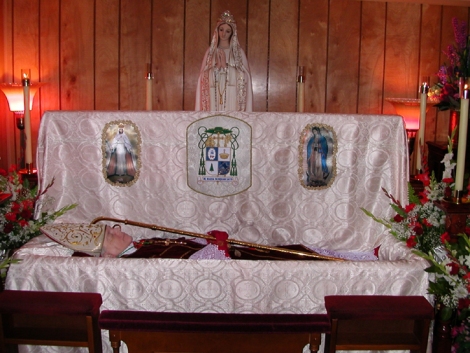
* * * * * * * * * * * * * * * * * * * * * * * * * * * * * * *
Some Final Moments with Our Spiritual Father
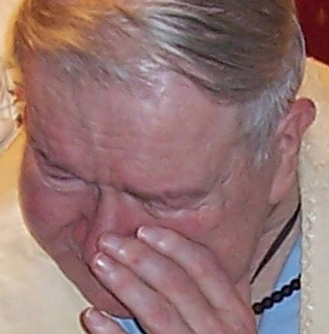 |
Tears of Joy Immediately after Bishop Joseph Marie's First Mass |
| One of His Last Treks Outside |
|
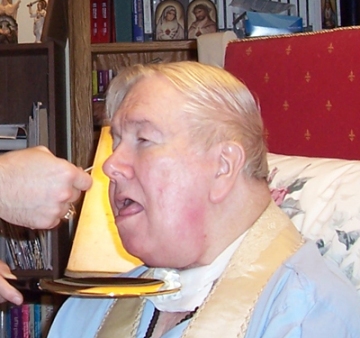 |
Reception of Holy Communion for the First Time from Newly Consecrated Bishop |
| Carrying His Cross with His Customary Smile |
 |
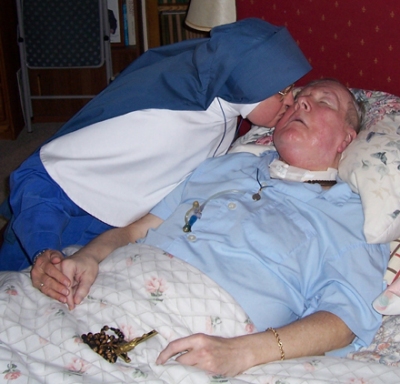 |
One Final Farewell to Her Spiritual Father |
May He Rest in Peace!
Church Website
Bishop Schuckardt's Email Address:
mailto:bishopfrancismaria@gmail.com
Home Page
Validity and Liceity of Orders
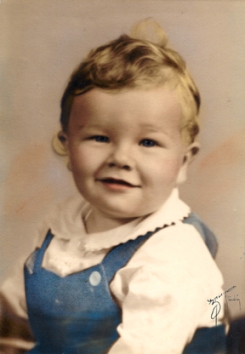
1Official Manual for the Blue Army (circa 1966).